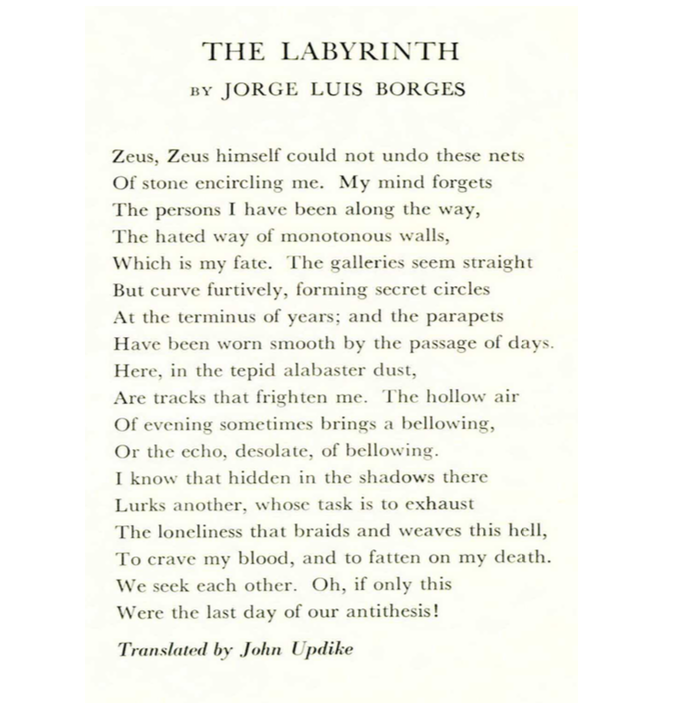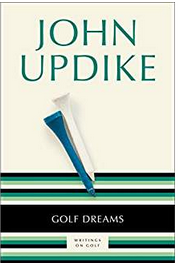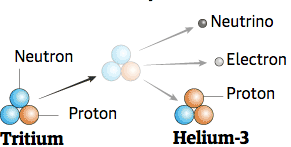Dark web. Deep AI. Sounds sinister, doesn’t it? And one could picture it becoming so in an Updike novel . . . or at least something that leads to unintended consequences. Now you can “chat” with John Updike via Deep AI (artificial intelligence). Fans of Updike know how much he loved words and the physicality of words on the page and books in the hand, and know how much he even resented interviewers and biographers for “mining” his life. Certainly he would find this unsettling, wouldn’t he? Some readers will embrace this; others will not even want to click on this Pandora’s Box. But here it is.
Category Archives: Updike Online
SpongeBob RabbitPants?
Greg EplerWood reported that Rabbit Run, the section of a tiny not-quite-a-creek near Shillington named in honor of Updike’s second novel, has an uncommon resident: a yellow, freshwater sponge.
Last summer, Angelica Creek Watershed Association’s Jill and Stan Kemp sent an email to other members with news that they had discovered a strange yellow growth underneath one of the rocks. Suspecting it might be a seldom-seen freshwater sponge, they sent a sample to Carnegie Museum’s Marc Yergin, who studied it “Under the Microscope”—as Updike might have done. Yergin tentatively identified it as Eunapius fragilus.
Though Updike’s short story about microscopic life was a commentary on the New York literary scene, what the presence of a freshwater sponge in Rabbit Run means is that the association’s clean-up has already had a positive effect on the ecosystem.
“The presence of FW sponge indicates good water quality as they are extremely sensitive to any type of water pollution,” the Kemps wrote. “Sponges provide an important ecosystem service because they filter water all day, every day and help to clean things up like FW mussels or oysters in Chesapeake.”
The Kemps said they thought some of the improvements in the management of the riparian area might have helped this sponge to survive in Rabbit Run . . . a long, long ways from Bikini Bottom.
Photos are courtesy of the Kemps and Marc Yergin. The longish skeletal elements from the magnified sponge below are called “spicules.”
Maverick Philosopher on Updike’s Seven Stanzas at Easter
This time of year John Updike’s poem “Seven Stanzas at Easter” is often reprinted and just as often pondered.
The most recent to tackle the poem is the Maverick Philosopher, who is listed among The Times of London’s 100 Best Blogs.
 Bill Vallicella (aka Maverick Philosopher) writes, “Given what we know from yesterday’s Updike entry, the suspicion obtrudes that, while Updike clearly understands the Resurrection as orthodoxy understands it, his interest in it is merely aesthetic in Kierkegaard’s sense, and not ethical in the Dane’s sense, which suspicion comports well with the charge that Updike radically divorced Christian theology from Christian ethics.
Bill Vallicella (aka Maverick Philosopher) writes, “Given what we know from yesterday’s Updike entry, the suspicion obtrudes that, while Updike clearly understands the Resurrection as orthodoxy understands it, his interest in it is merely aesthetic in Kierkegaard’s sense, and not ethical in the Dane’s sense, which suspicion comports well with the charge that Updike radically divorced Christian theology from Christian ethics.
“Or perhaps, as a Protestant, Updike thinks that since God in Christ did all the work of atonement, he needn’t do anything such as reform his life and struggle and strive for metanoia but can freely enjoy himself in the arms and partake of the charms of other men’s wives. Am I being fair?”
Is he?
Blogger considers Updike on Van Gogh
 John MacDougall posted a May 1 2019 entry on his blog, The New Yorker and Me, titled “Updike on Van Gogh,” in which he draws attention to “Updke’s great posthumous essay collection Higher Gossip” and considers what he considers to be the two best pieces: “Uncertain Skills, Determined Spirit” and “The Purest of Styles.” Both deal with van Gogh, MacDougall’s “favorite painter.”
John MacDougall posted a May 1 2019 entry on his blog, The New Yorker and Me, titled “Updike on Van Gogh,” in which he draws attention to “Updke’s great posthumous essay collection Higher Gossip” and considers what he considers to be the two best pieces: “Uncertain Skills, Determined Spirit” and “The Purest of Styles.” Both deal with van Gogh, MacDougall’s “favorite painter.”
MacDougall quotes from both essays, in particular paying notice to his favorite passage in “Uncertain Skills” that “contrasts van Gogh’s two pen copies of his superb Harvest in Provence.” Of Updike’s assessment that “The drawings brim with latent color” he writes, “That last line is inspired.
Updike’s translation of Borges poem now online
Last month The Atlantic delved into their archives and pulled out “The Labyrinth,” a poem by Jorge Luis Borges that was translated by John Updike and published in their April 1969 issue. Even the most ardent fans might find themselves thinking, on top of everything else, Updike was also a translator?

“From the Archives: ‘The Labyrinth,’ a Poem by Jorge Luis Borges”
On Updike’s birthday, site unearths the first “Rabbit” reviews
The “Book Marks” website celebrated what would have been John Updike’s 87th birthday with a list of early reviews to the “Rabbit” novels for which the author is most famous. Here are a few of them:
“Rabbit, Run is a tender and discerning study of the desperate and the hungering in our midst. A modest work, it points to a talent of large dimensions—already prove in the author’s New Yorker stories and his first novel, The Poorhouse Fair, John Updike, still only 28 years old, is a man to watch.”
–David Boroff, The New York Times, November 6, 1960
“There is a great deal in Rabbit Redux, but only because John Updike has put it there. There is more activity than purposefulness: an intricate scheme of parallelisms with the moon shot; a rich (but in the end funked or slighted) sense of possible parallels between oral sex and verbalism or certain verbal habits; likewise a sense of parallels between the job of linotyping and the job of writing. The book is cleverer than a barrel full of monkeys, and about as odd in its relation of form to content. It never decides just what the artistic reasons (sales and nostalgia are another matter) were for bringing back Rabbit instead of starting anew; its existence is likely to do retrospective damage to that better book Rabbit, Run.”
–Christopher Ricks, The New York Review of Books, December 16, 1971

“If Rabbit Is Rich has a central theme it has to do with the one-directional nature of life: life, always waiting to be death. Rabbit swans on down the long slide, clumsy, lax and brutish, but vaguely trying.
“The technical problem posed by Rabbit is a familiar and fascinating one. How to see the world through the eyes of the occluded, the myopic, the wilfully blind? At its best the narrative is a rollicking comedy of ironic omission, as author and reader collude in their enjoyment of Rabbit’s pitiable constriction. Conversely, the empty corners and hollow spaces of the story fill with pathos, the more poignant for being unremarked.”
–Martin Amis, The Observer, January 17, 1982
“Rabbit at Rest is certainly the most brooding, the most demanding, the most concentrated of John Updike’s longer novels. Its courageous theme—the blossoming and fruition of the seed of death we all carry inside us—is struck in the first sentence … This early note, so emphatically struck, reverberates through the length of the novel and invests its domestic-crisis story with an unusual pathos. For where in previous novels, most famously in Couples (1968), John Updike explored the human body as Eros, he now explores the body, in yet more detail, as Thanatos. One begins virtually to share, with the doomed Harry Angstrom, a panicky sense of the body’s terrible finitude, and of its place in a world of other, competing bodies: ‘You fill a slot for a time and then move out; that’s the decent thing to do: make room.’”
–Joyce Carol Oates, The New York Times, September 30, 1990
“The centerpiece of [Licks of Love]—and the one compelling reason to read it—is a novella-length piece called ‘Rabbit Remembered,’ a sad-funny postscript to Mr. Updike’s quartet of Rabbit novels, which takes up the story of Harry (Rabbit) Angstrom’s family and friends as they try to come to terms with his death and chart the remainder of their own lives.
“As in his last Rabbit novel, Mr. Updike writes with fluent access to Harry Angstrom’s world, chronicling the developments in his hero’s small Pennsylvania hometown with the casual ease of a longtime intimate. With compassion and bemused affection, he traces the many large and small ways in which Harry’s actions continue to reverberate through the lives of his widow, Janice, and their son, Nelson, and the equally myriad ways in which their decisions are influenced, consciously or unconsciously, by their memories of him.
Golf Digest republishes Updike’s paean to December golf
“Just as a day may come at sunset into its most glorious hour, or a life toward the gray-bearded end enter a halcyon happiness, December golf, as long as it lasts, can seem the sweetest golf of the year,” John Updike wrote in an essay that first appeared in the December 1989 issue of Golf Digest.
That essay was recently republished and can be read online now, as so many things can.

“The course itself—its ice-edged water hazards, its newly erected snow fences—seems grateful to be visited” . . . as golfers and Updike fans are to have this essay in its entirety pop up this December.
Here’s the link.
“You seem to be, in December golf, reinventing the game, in some rough realm predating 15th-century Scotland,” Updike wrote, exhilarated by the “boarded-up clubhouse” and “naked trees” and absence of crowds in colorful clothing: “just golf-mad men and women, wearing wool hats and two sweaters each, moving on their feet” with a “running tally carried in the head of the accountant or retired banker in the group,” Updike wrote.
Updike on the ghost particle of the universe
In an article titled “In search of the neutrino, ghost particle of the universe,” The Guardian turned to John Updike again.
“Every second,” Robin McKie writes, “billions of neutrinos pass through our bodies. The sun sends trillions streaming across space every minute. Uncountable numbers have been left over from the Big Bang birth of the cosmos 13.8 billion years ago.
 “In fact, there are more neutrinos in the universe than any other type of particle of matter, though hardly anything can stop these cosmological lightweights in their paths. And this inability to interact with other matter has made them a source of considerable frustration for scientists who believe neutrinos could bring new understandings to major cosmological problems, including the nature of dark matter and the fate of our expanding universe. Unfortunately, the unbearable lightness of their being makes them very difficult to study.”
“In fact, there are more neutrinos in the universe than any other type of particle of matter, though hardly anything can stop these cosmological lightweights in their paths. And this inability to interact with other matter has made them a source of considerable frustration for scientists who believe neutrinos could bring new understandings to major cosmological problems, including the nature of dark matter and the fate of our expanding universe. Unfortunately, the unbearable lightness of their being makes them very difficult to study.”
The article notes, “Three different forms of the particle are now known to exist: the electron neutrino, the muon neutrino and the tau neutrino and until relatively recently it was thought that none of them had any mass at all. They were the ultimate in ephemeral ghostliness, a bizarre situation that was celebrated by John Updike in his poem, ‘Cosmic Gall.'”
Neutrinos, they are very small.
They have no charge and have no mass
And do not interact at all.
The earth is just a silly ball
To them, through which they simply pass,
Like dustmaids down a drafty hall
Updike’s baseball poem recalled
A blogger on The Nature of Things posted an entry titled “Houston, we have a World Series champion! in celebration of the team’s (and city’s) first World Series championship.
“Baseball is a game that will break your heart two times out of three,” Dorothy Borders writes. “But, oh, that third time is worth waiting for.
“John Updike knew and loved the game and explained it best of all. Let’s give him the last word and then, let the off-season begin!”
Baseball
easy and lazy, even,
until you stand up to the plate
and see the fastball sailing inside,
an inch from your chin,
or circle in the outfield
straining to get a bead
on a small black dot
a city block or more high,
a dark star that could fall
on your head like a leaden meteor.
The grass, the dirt, the deadly hops
between your feet and overeager glove:
football can be learned,
and basketball finessed, but
there is no hiding from baseball
the fact that some are chosen
and some are not—those whose mitts
feel too left-handed,
who are scared at third base
of the pulled line drive,
and at first base are scared
of the shortstop’s wild throw
that stretches you out like a gutted deer.
There is nowhere to hide when the ball’s
spotlight swivels your way,
and the chatter around you falls still,
and the mothers on the sidelines,
your own among them, hold their breaths,
and you whiff on a terrible pitch
or in the infield achieve
something with the ball so
ridiculous you blush for years.
It’s easy to do. Baseball was
invented in America, where beneath
the good cheer and sly jazz the chance
of failure is everybody’s right,
beginning with baseball.
Updike included in on-air trilogy
 On WNYC guest host Sonia Manzano presented three works about “entering uncharted territories.”
On WNYC guest host Sonia Manzano presented three works about “entering uncharted territories.”
“An early John Updike fable, ‘The Different One,’ imagines a bold bunny. It’s read by Michael Emerson. A gentrified town morphs into a dreamscape in Steven Millhauser’s ‘Coming Soon,’ read by David Morse. And Kristin Valdez Quade’s essay ‘Youth from Every Quarter’ looks at the harsher side of assimilation. It’s read by Manzano.”
Recorded live at Symphony Space in New York City.



